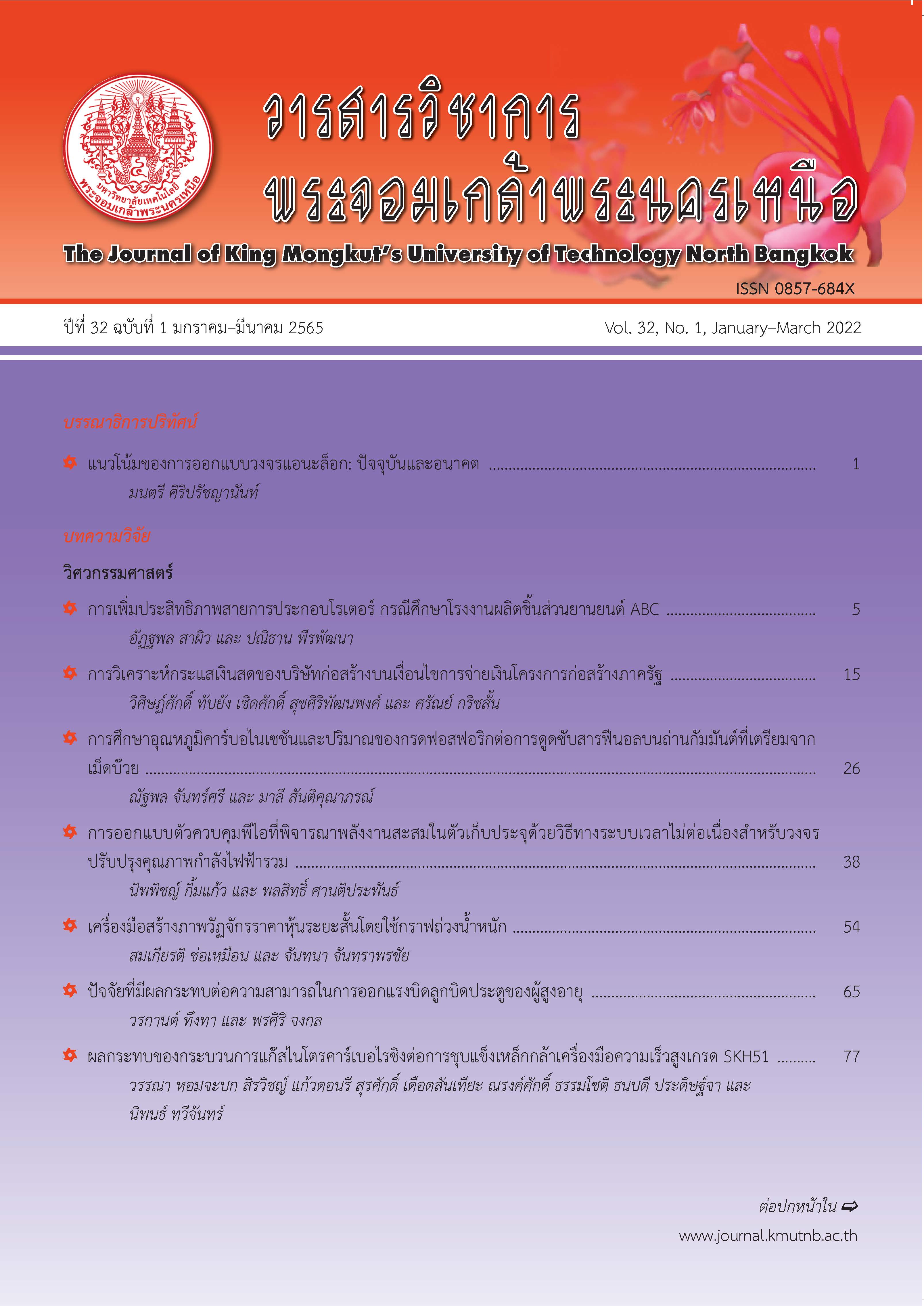สมรรถนะการถ่ายโอนความร้อนของหม้อต้มเทอร์โมไซฟอนวงจรปิด
Main Article Content
บทคัดย่อ
หม้อต้มเทอร์โมไซฟอนวงจรปิดเป็นอุปกรณ์แลกเปลี่ยนความร้อนที่มีลักษณะการทำงานเหมือนกับเทอร์โมไซฟอนชนิดวงจร การวิจัยครั้งนี้เพื่อศึกษาเปรียบเทียบสมรรถนะของอุปกรณ์แลกเปลี่ยนความร้อนที่มีอีวาโปเรเตอร์เป็นหม้อต้มและมีปริมาตรมากกว่า 95 เปอร์เซนต์ของปริมาตรรวมทั้งหมด โดยใช้น้ำ เอทานอล และอะซิโตน เป็นสารทำงาน หม้อต้มเทอร์โมไซฟอนวงจรปิดทำด้วยวัสดุทองแดงทั้งระบบมีปริมาตรช่องว่างรวมทั้งหมดเท่ากับ 3.14×10-3 ลูกบาศก์เมตร ทำการทดสอบสมรรถนะแบบควบคุมฟลักซ์ความร้อนให้คงที่ในช่วง 50–120 กิโลวัตต์/ตารางเมตรคอนเดนเซอร์ระบายความร้อนด้วยน้ำเย็นที่มีอุณหภูมิและอัตราการไหลเชิงมวลคงที่ ผลการทดลองพบว่าสารทำงานต่างชนิดกันมีผลต่อสมรรถนะในการถ่ายโอนความร้อนแตกต่างกัน โดยเมื่อพิจารณาด้วยค่าความต้านทานความร้อนรวม (Z) จะพบว่าอะซิโตนจะให้สมรรถนะในการถ่ายโอนความร้อนสูงกว่าเอทานอลและน้ำเมื่อฟลักซ์ความร้อนไม่เกิน 80 กิโลวัตต์/ตารางเมตร นอกจากนี้ยังพบว่าน้ำจะให้สมรรถนะในการถ่ายโอนความร้อนสูงกว่าอะซิโตนและเอทานอลเมื่อฟลักซ์ความร้อนสูงกว่า 90 กิโลวัตต์/ตารางเมตร
Article Details
บทความที่ลงตีพิมพ์เป็นข้อคิดเห็นของผู้เขียนเท่านั้น
ผู้เขียนจะต้องเป็นผู้รับผิดชอบต่อผลทางกฎหมายใดๆ ที่อาจเกิดขึ้นจากบทความนั้น
เอกสารอ้างอิง
[2] B. Aghel, M. Rahimi, and S. Almasi, “Heat transfer enhancement of two‑phase closed thermosyphon using a novel cross‑flow condenser,” Heat Mass Transfer, vol. 53, pp. 765–773, 2017.
[3] D. Jafari, P. Marco, S. Filippeschi, and A. Franco, “An experimental investigation on the evaporation and condensation heat transfer of two-phaseclose thermosyphons,” Experimental Thermal and Fluid Science, vol. 88, pp. 111–123, 2017.
[4] Z. Lataoui and A. Jemni, “Experimental investigation of a stainless steel two-phase closed thermosyphon,” Applied Thermal Engineering, vol. 121, pp. 721–727, 2017.
[5] Y. Naresh and C. Balaji, “Experimental investigations of heat transfer from an internally finned two phase closed thermosyphon,” Applied Thermal Engineering, vol. 112, pp. 1658–1666, 2017.
[6] Y. Kim, D.H. Shina, J.S. Kim, S.M. Youb, and J. Leea, “Boiling and condensation heat transfer of inclined two-phase closed thermosyphon with various filling ratios,” Applied Thermal Engineering, vol. 145, pp. 328–342, 2018.
[7] S. Chen and J. Yang, “Loop thermosyphon performance study for solar cells cooling,” Energy Conversion and Management, vol. 121, pp. 297–304, 2016.
[8] E. Gedik, “Experimental investigation of the thermal performance of atwo-phase closed thermosyphon at different operating con-ditions,” Energy and Buildings, vol. 127, pp. 1096–1107, 2016.
[9] T. Sukchana and V. Thadniam, “Effect of position of evaporator and condenser on heat transfer performance of R-134a loop thermosyphon,” UBU Engineering Journal, vol. 12, no. 1, pp. 25–33, 2019 (in Thai).
[10] T. Sukchana, “Heat transfer performance of a single-pipe thermosyphon with adiabatic length of 7.5Le employing environmentally friendly refrigerant as a working fluid,” KMUTT Research and Development Journal, vol. 42, no. 4, pp. 345–388, 2019 (in Thai).
[11] T. Sukchana, “Study of heat transfer performance of a loop thermosyphon using an environmentfriendly refrigerants as a working fluid,” The Journal of KMUTNB, vol. 30, no. 2, pp. 199–208, 2020 (in Thai).
[12] T. Sukchana and N. Pratinthong, “Effect of bending position on heat transfer performance of R-134a two-phase close loop thermosyphon with an adiabatic section using flexible hoses,” International Journal of Heat and Mass Transfer, vol. 114, pp. 527–535, 2017.
[13] Z. Tong, X. H. Liu, and Y. Jiang, “Three typical operating states of an R744 two-phase ther-mosyphon loop,” Applied Energy, vol. 206, pp. 181–192, 2017.
[14] Z. Tong, X. H. Liu, and Y. Jiang, “Experimental study of the self-regulating performance of an R744 two-phase thermosyphon loop,” Applied Energy, vol. 186, pp. 1–12, 2017.
[15] A.A. Chehade, H. Louahlia-Gualous, S. Le Masson, I. Victor, and N. Abouzahab-Damaj, “Experimental investigation of thermosyphon loop thermal performance,” Energy Conversion and Management, vol. 84, pp. 671–680, 2014.
[16] Z. Q. Long and P. Zhang, “Impact of cooling condition and filling ratio on heat transfer limit of cryogenic thermosyphon,” Cryogenics, vol. 52, pp. 66–76, 2012.
[17] Z. Q. Long and P. Zhang, “Heat transfer characteristics of thermosyphon with N2–Ar binary mixture working fluid,” International Journal of Heat and Mass Transfer, vol. 63, pp. 204–215, 2013.
[18] K. G. Kannan and R. Kamatchi, “Augmented heat transfer by hybrid thermosyphon assisted thermal energy storage system for electronic cooling,” Journal of Energy Storage, vol. 27, pp. 1–10, 2020.
[19] L. Zied and J. Abdelmajid, “Experimental investigation of a stainless steel two-phase closed thermosyphon,” Applied Thermal Engineering, vol. 121, pp. 721–727, 2017.
[20] Y.Naresh and C. Balaji, “Thermal performance of an internally finned two phase closed thermosyphon with refrigerant R134a: A combined experimental and numerical study,” International Journal of Thermal Sciences, vol. 126, pp. 281–293, 2018.
[21] Y. Naresh and C. Balaji, “Experimental investigations of heat transfer from an internally finned two phase closed thermosyphon,” Applied Thermal Engineering, vol. 112, pp. 1658–1666, 2017.

